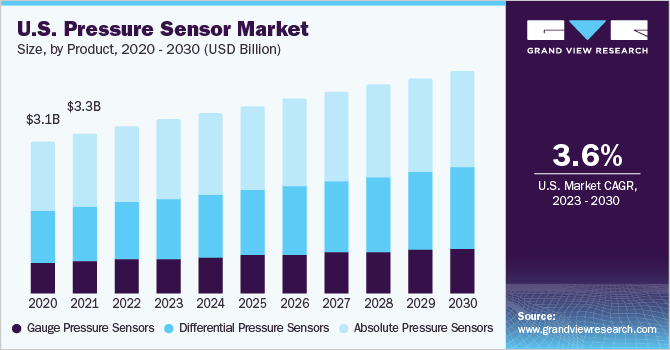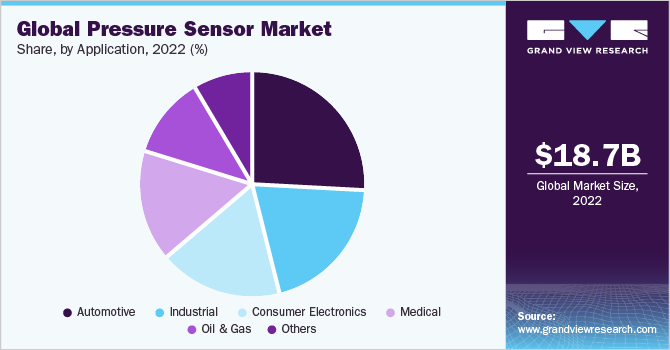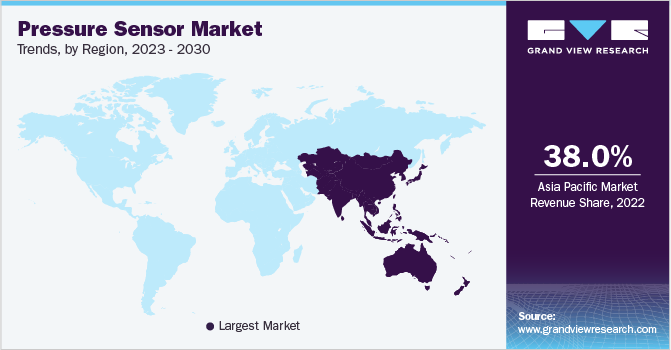- Home
- »
- Next Generation Technologies
- »
-
Pressure Sensor Market Size, Share, Trends Report, 2030GVR Report cover
![Pressure Sensor Market Size, Share & Trends Report]()
Pressure Sensor Market Size, Share & Trends Analysis Report By Product (Differential, Absolute), By Type (Wireless, Wired), By Technology (Capacitive, Optical), By Application (Oil & Gas, Medical), And Segment Forecasts, 2023 - 2030
- Report ID: 978-1-68038-246-4
- Number of Report Pages: 110
- Format: PDF, Horizon Databook
- Historical Range: 2017 - 2021
- Forecast Period: 2023 - 2030
- Industry: Technology
Pressure Sensor Market Size & Trends
The global pressure sensor market size was valued at USD 18.73 billion in 2022 and is expected to grow at a compound annual growth rate (CAGR) of 4.3% from 2023 to 2030. The market’s growth can be attributed to the rising demand for pressure sensors from various industry verticals, such as automotive and healthcare, and in various applications, such as consumer electronics, portable healthcare wearables, alarm systems, medical breathing appliances, water purifiers, refrigeration systems, and off-road constructions among others. Moreover, technological development has led to the production of compact, cost-effective, and even smart pressure sensors that can be linked to smart devices for accurate measurements, significantly contributing to the market’s demand.

The growing use of pressure sensors in home appliances, such as refrigerators and washing machines, is driving the demand for pressure sensors. Numerous pressure sensor providers are also focusing on developing innovative products to cater to the increasing demand from the consumer electronics sector. For instance, in March 2021, Bosch Sensortec, a pressure sensor provider, launched BMP384, which is a robust barometric pressure sensor. BMP384 is a high-performance and low-consumption sensor, which makes it ideal for home appliances, wearables, and industrial applications in harsh environments. Such product launches are harnessing innovation and growth in the market.
Several OEMs have started using Microelectromechanical Systems (MEMS) pressure sensors in smartphones, tablets, and wearables. For instance, Samsung has integrated pressure sensors in its flagship phone Galaxy S4. Other handset makers, such as Sony Mobile Communications AB, Apple Inc., and Xiaomi Inc., have also started using MEMS pressure sensors in their respective smartphones. Consumers’ preference for compact consumer electronics and the advances in MEMS technology have also enabled the development of sensors that are smaller in size. As a result, the adoption of MEMS pressure sensors in consumer electronics is growing, thereby contributing to the overall market’s growth.
In recent years, the automotive industry is undergoing a technology transition with an increasing focus on comfort and safety, which provides ample opportunities for the development of pressure sensors. At the same time, increasing sensor-rich applications in drones, autonomous vehicles, and AR/VR equipment are further accelerating the demand for MEMS pressure sensors. Moreover, the increasing military spending across regions is also paving the way for technologies like drones and Unmanned Aerial Vehicles (UAVs). Such factors bode well for the growth of the market over the forecast period.
Various companies across the globe are focusing on providing pressure sensors with built-in IoT systems. Pressure sensors are used in IoT systems to monitor devices and systems driven by pressure signals. For instance, in April 2022, Trusted A/S announced the launch of its new tracking device and data logger series. The series features precision relative humidity, temperature, and pressure sensors in a single IoT wireless device. This launch enables wireless IoT devices to track relative humidity, temperature, and pressure along with motion, shock, light, and tilt. Such initiatives are anticipated to drive the market’s growth over the forecast period.
COVID-19 Impact Analysis
The COVID-19 pandemic has had a mixed impact on the market. While demand for pressure sensors in some industries, such as automotive and industrial, has declined due to disruptions in supply chains and reduced production, other industries, such as healthcare and consumer electronics, have seen increased demand for pressure sensors. In healthcare, the demand for pressure sensors has risen due to the need to monitor the vital signs of COVID-19 patients. The pandemic has also accelerated the adoption of telemedicine and remote patient monitoring, further increasing the demand for pressure sensors in healthcare. Product usage in consumer electronics has also increased as more people work from home and rely on devices, such as smartphones and wearables, for communication and fitness tracking. Overall, the pandemic adversely affected the market in the short term, but the long-term outlook remains positive.
Product Insights
The absolute pressure sensor segment dominated the market in 2022 and accounted for more than 43.0% share of the global revenue. An absolute pressure sensor is a closed system that references a perfect vacuum and creates pressure readings unaffected by atmospheric pressure. Absolute pressure sensors are used in applications requiring industrial, high-performance vacuum pump monitoring. The growing demand for error-free engine functionality to manufacturing safe and secure vehicles is a significant factor driving the segment's growth. Moreover, the increasing demand for these absolute pressure sensors for vacuum packaging medical products in a clean environment further boosts the segment’s growth.
The differential pressure sensor segment is anticipated to register the highest growth rate over the forecast period. Differential pressure sensors are used in industrial environments where a pressure difference is utilized to determine the flow of liquids and gases. Numerous differential pressure sensor providers are striking partnerships with other companies to obtain technical support for various industrial applications. For instance, in June 2021, Superior Sensor Technology, a differential pressure sensor developer, announced its partnership with Angst+Pfister Sensors and Power, a power and sensor solution provider. Through this partnership, Angst+Pfister Sensors and Power would distribute, promote, and provide technical support for Superior Sensor’s pressure sensors for medical, HVAC, and industrial applications in Europe.
Type Insights
The wired segment dominated the market in 2022 and accounted for more than 85.0% share of the global revenue. A wired pressure sensor is available in different technologies, such as photoelectric, capacitive, and inductive. The rising demand for wired pressure sensors in the industrial, automotive, and other sectors, owing to their lower radio frequency interference, smaller size, compatibility between manufacturers, and lower cost installation properties is expected to drive the growth of the segment over the forecast period. Lower power consumption by a wired pressure sensor is further contributing to segment growth.
The wireless segment is expected to register the fastest growth rate over the forecast period. The benefits offered by wireless pressure sensors, such as ease of portability, enhanced safety, and cost-effectiveness, are expected to drive the growth of the segment. The increasing use of wireless pressure sensors in applications, such as consumer products, industrial automation & manufacturing, air compressor monitoring, and pool pump systems is expected to drive the segment growth over the forecast period. Self-contained, wellhead pressure, battery-powered monitoring, and casing pressure monitoring solutions are propelling the growth of the wireless-type segment.
Technology Insights
The piezoresistive segment dominated the market in 2022 and accounted for more than 26.0% share of the global revenue. The rising adoption of piezoresistive pressure sensors in cars and passenger vehicles for better emission and safety is a major factor driving the segment's growth. Piezoresistive pressure sensors are used in a wide range of aerospace and industrial applications owing to their robustness, rapid response time, and high frequency. Several manufacturers are focusing on developing waterproof sensors that are resistant to external disturbances. For instance, in October 2021, Rohm Semiconductor, a pressure sensor provider, released BM1390GLV-Z, a waterproof barometric pressure sensor based on piezoresistive MEMS technology.
Such initiatives are harnessing the segment’s growth.The electromagnetic segment is anticipated to register the fastest growth rate over the forecast period. A growing focus on the property of converting applied pressure into an electrical signal by the electromagnetic pressure sensor is expected to drive the demand for these sensors in electrical applications. Benefits, such as high efficiency, low cost, and suitability, of electrical applications are further anticipated to propel the segment growth. According to the statistics provided by the Federal Reserve Bank of St. Louis, USD 82.74 billion were spent on household appliances in 2022 compared to USD 70.43 billion in 2021 in the U.S. alone. Thus, the increasing sales of home appliances are driving the segment's growth.
Application Insights
The automotive segment dominated the market in 2022 and accounted for more than 25.0% share of the global revenue. Pressure sensors are used in electric cars to stop the doors from catching fingers. Moreover, numerous pressure sensor companies worldwide are developing and launching new pressure sensors and systems to measure the dynamic pressure system in moving vehicles. In addition, pressure sensors are also used in engine management systems to monitor intake manifold pressure and optimize fuel delivery. This can help improve fuel efficiency and reduce emissions. These benefits are boosting the product demand in the automotive segment.

The industrial segment is anticipated to register the fastest growth rate over the forecast period. Differential pressure sensors are used for monitoring process flows where fluid needs to pass through barriers, such as a filter. A differential pressure sensor used in industrial applications provides benefits, such as oil-free designs, high-proof pressure ratings, increased resolution, and better accuracy. Furthermore, the increasing use of pressure sensors in applications, such as transmissions and oil & gas equipment, is driving the segment growth.
Regional Insights
The Asia Pacific region dominated the market in 2022 and accounted for over 38.0% share of the global revenue. The growth of the region can be attributed to the large-scale production of electronic components as well as the rising investments in R&D. The increasing demand for consumer electronics, such as tablets, wearable devices, and smartphones, is driving the demand for pressure sensors in this region. India and China are contributing to a large share of the regional market. China is a mature marketplace and features strong business opportunities.

For instance, in July 2021, Danfoss Group, a market leader in software and engineering technologies, announced that it has heavily invested in the market and is expected to accelerate the growth of China's pressure sensors market. North America is expected to register a significant growth rate over the forecast period. The North America regional market is projected to witness growth owing to the high demand for pressure sensors in TPMS and EGR system applications in the automotive segment. The presence of key players in the region is also one of the major factors driving the market growth. At the same time, the increasing demand for pressure sensors in industries, such as oil & gas, petrochemical, and medical, is also accelerating the market growth in this region.
Key Companies & Market Share Insights
The competitive landscape of the market is highly fragmented. Market players are focused on strategies, such as partnerships, joint ventures, product innovation, research & development, and geographical expansion, to strengthen their market positions. Furthermore, key players are investing in research & development activities to launch new products to cater to the changing consumer preferences. Key market players are launching devices suitable for specific applications in industries, such as automotive, industrial, oil & gas, consumer electronics, and medical and environmental monitoring.
For instance, in April 2023, Valeport, a manufacturer of environmental sensors, announced it will launch the latest offering, the SwiFT Deep CTD. This product is specifically designed to facilitate CTD measurements up to 6,000 meters in depth. The launch of this product is aimed at providing users with the advantages of density-corrected output, coupled with the flexibility of incorporating third-party pressure sensor input, and Valeport's interchangeable pressure modules. The intent is to improve accuracy levels for users operating at different depths. Such initiatives are harnessing the competitive landscape of the market. Some of the prominent players in the global pressure sensor market include:
-
AlphaSense
-
City Technology Ltd.
-
Dynament Ltd.
-
Figaro Engineering Inc.
-
Membrapor
-
Nemoto Kyorindo co., Ltd.
-
Robert Bosch GmbH
-
ABB Ltd.
-
Siemens
-
GfG Europe Ltd.
Pressure Sensor Market Report Scope
Report Attribute
Details
Market size value in 2023
USD 19.66 billion
Revenue forecast in 2030
USD 26.37 billion
Growth rate
CAGR of 4.3 % from 2023 to 2030
Base year of estimation
2022
Historical data
2017 - 2021
Forecast period
2023 - 2030
Report updated
May 2023
Quantitative units
Revenue in USD million/billion and CAGR from 2022 to 2030
Report coverage
Revenue forecast, company ranking, competitive landscape, growth factors, and trends
Segments covered
Product, type, technology, application, region
Regional scope
North America; Europe; Asia Pacific; Latin America; Middle East & Africa
Country scope
U.S.; Canada; Mexico; UK; Germany; France; Nordic Region; China; Japan; India; Australia; Brazil; Argentina; UAE; Saudi Arabia
Key companies profiled
AlphaSense; City Technology Ltd.; Dynament Ltd.; Figaro Engineering Inc.; Membrapor; Nemoto Kyorindo co., Ltd.; Robert Bosch GmbH; ABB Ltd.; Siemens; GfG Europe Ltd.
Customization scope
Free report customization (equivalent to up to 8 analysts working days) with purchase. Addition or alteration to country, regional, and segment scope
Pricing and purchase options
Avail customized purchase options to meet your exact research needs. Explore purchase options
Global Pressure Sensor Market Report Segmentation
This report forecasts revenue growth and provides an analysis of the latest trends in each of the sub-segments from 2017 to 2030. For this report, Grand View Research has segmented the pressure sensor market based on product, type, technology, application, and region:
-
Product Outlook (Revenue, USD Million, 2017 - 2030)
-
Absolute Pressure Sensors
-
Differential Pressure Sensors
-
Gauge Pressure Sensors
-
-
Type Outlook (Revenue, USD Million, 2017 - 2030)
-
Wired
-
Wireless
-
-
Technology Outlook (Revenue, USD Million, 2017 - 2030)
-
Piezoresistive
-
Electromagnetic
-
Capacitive
-
Resonant Solid-State
-
Optical
-
Others
-
-
Application Outlook (Revenue, USD Million, 2017 - 2030)
-
Automotive
-
Oil & Gas
-
Consumer Electronics
-
Medical
-
Industrial
-
Others
-
-
Regional Outlook (Revenue, USD Million, 2017 - 2030)
-
North America
-
U.S.
-
Canada
-
Mexico
-
-
Europe
-
UK
-
Germany
-
France
-
Nordic Region
-
-
Asia Pacific
-
China
-
Japan
-
India
-
Australia
-
-
Latin America
-
Brazil
-
Argentina
-
-
Middle East & Africa
-
UAE
-
Saudi Arabia
-
-
Frequently Asked Questions About This Report
b. The global pressure sensor market size was estimated at USD 18.73 billion in 2022 and is expected to reach USD 19.66 billion in 2023.
b. The global pressure sensor market is expected to grow at a compound annual growth rate of 4.3% from 2023 to 2030 to reach USD 26.37 billion by 2030.
b. The Asia Pacific region dominated the market in 2022. The growth of the region can be attributed to the large-scale production of electronic components as well as the rising investments in the R&D. The increasing demand for consumer electronics such as tablets, wearable devices, and smartphones is driving the demand for pressure sensors in this region. India and China are contributing to a large share of the regional pressure sensor market. China is a mature marketplace and features strong business opportunities.
b. Some key players operating in the pressure sensor market include AlphaSense, City Technology Ltd., Dynament Ltd., Figaro Engineering Inc., Membrapor, Nemoto Kyorindo co., Ltd., Robert Bosch GmbH, ABB Ltd., Siemens, and GfG Europe Ltd.
b. The market’s growth can be attributed to the rising demand for pressure sensors from various industry verticals, such as automotive and healthcare, and in various applications, such as consumer electronics, portable healthcare wearables, alarm systems, medical breathing appliances, water purifiers, refrigeration systems, and off-road constructions among others.
Share this report with your colleague or friend.
![gvr icn]()
NEED A CUSTOM REPORT?
We can customize every report - free of charge - including purchasing stand-alone sections or country-level reports, as well as offer affordable discounts for start-ups & universities. Contact us now
![Certified Icon]()
We are GDPR and CCPA compliant! Your transaction & personal information is safe and secure. For more details, please read our privacy policy.
We are committed towards customer satisfaction, and quality service.
"The quality of research they have done for us has been excellent."





